BN3720 Health & Safety: Construction Worker Registration System
VerifiedAdded on 2022/09/18
|10
|3531
|24
Report
AI Summary
This report assesses the worker registration system in Hong Kong's construction industry, focusing on health and safety management. It begins by highlighting the high-risk nature of construction work, citing accident statistics and the associated hazards. A systems model of accident causatio...
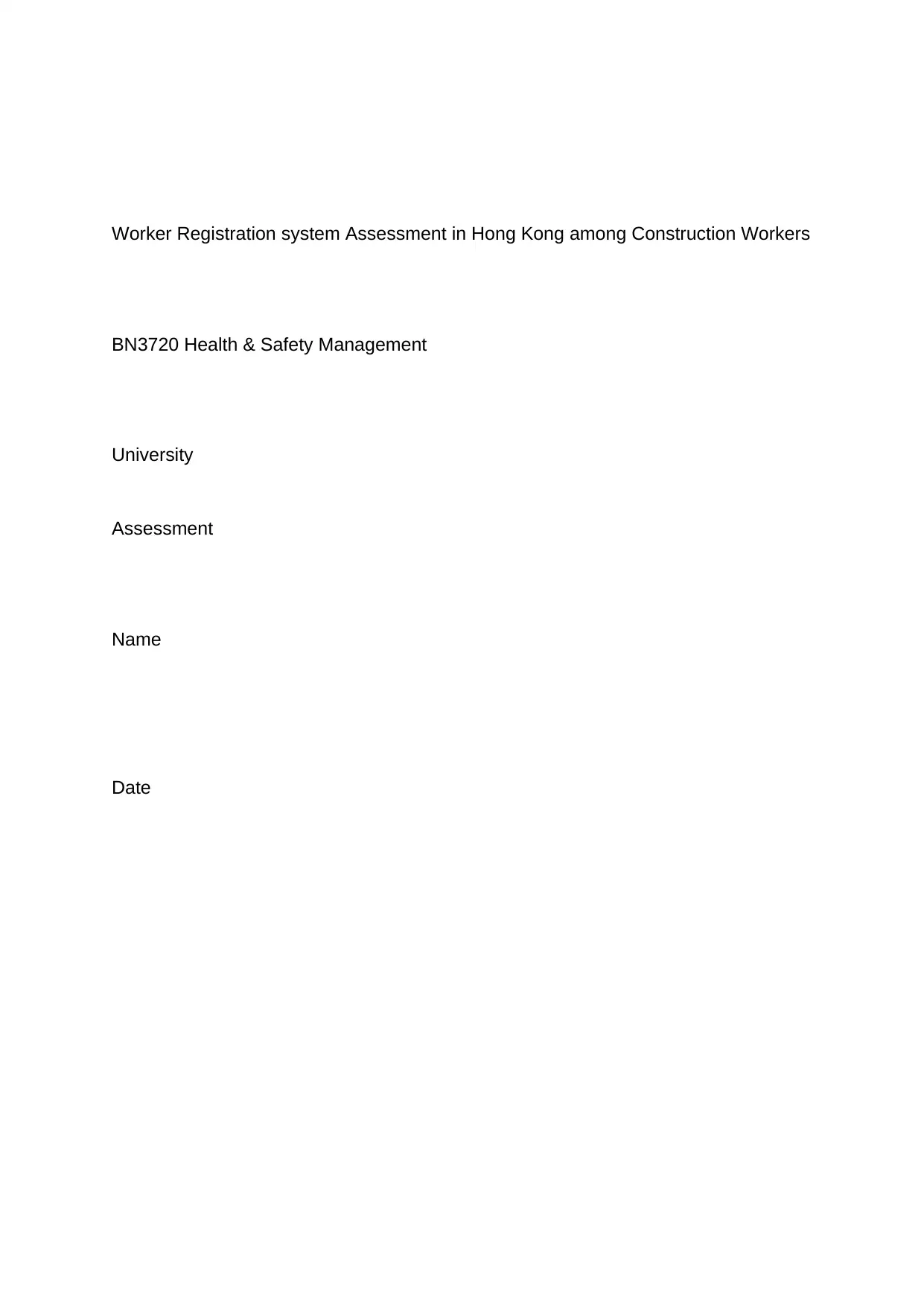
Worker Registration system Assessment in Hong Kong among Construction Workers
BN3720 Health & Safety Management
University
Assessment
Name
Date
BN3720 Health & Safety Management
University
Assessment
Name
Date
Paraphrase This Document
Need a fresh take? Get an instant paraphrase of this document with our AI Paraphraser
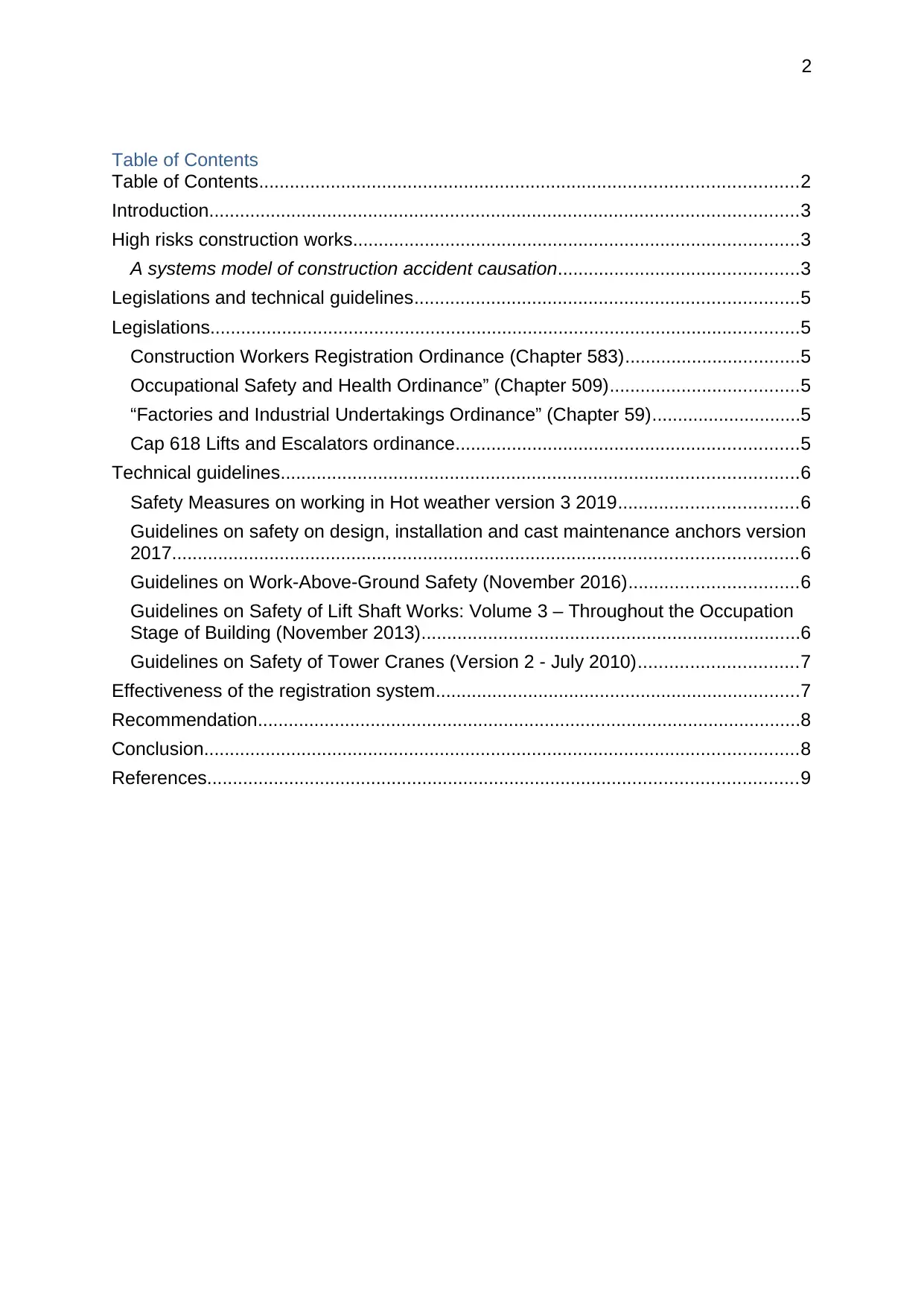
2
Table of Contents
Table of Contents.........................................................................................................2
Introduction...................................................................................................................3
High risks construction works.......................................................................................3
A systems model of construction accident causation...............................................3
Legislations and technical guidelines...........................................................................5
Legislations...................................................................................................................5
Construction Workers Registration Ordinance (Chapter 583)..................................5
Occupational Safety and Health Ordinance” (Chapter 509).....................................5
“Factories and Industrial Undertakings Ordinance” (Chapter 59).............................5
Cap 618 Lifts and Escalators ordinance...................................................................5
Technical guidelines.....................................................................................................6
Safety Measures on working in Hot weather version 3 2019...................................6
Guidelines on safety on design, installation and cast maintenance anchors version
2017..........................................................................................................................6
Guidelines on Work-Above-Ground Safety (November 2016).................................6
Guidelines on Safety of Lift Shaft Works: Volume 3 – Throughout the Occupation
Stage of Building (November 2013)..........................................................................6
Guidelines on Safety of Tower Cranes (Version 2 - July 2010)...............................7
Effectiveness of the registration system.......................................................................7
Recommendation..........................................................................................................8
Conclusion....................................................................................................................8
References...................................................................................................................9
Table of Contents
Table of Contents.........................................................................................................2
Introduction...................................................................................................................3
High risks construction works.......................................................................................3
A systems model of construction accident causation...............................................3
Legislations and technical guidelines...........................................................................5
Legislations...................................................................................................................5
Construction Workers Registration Ordinance (Chapter 583)..................................5
Occupational Safety and Health Ordinance” (Chapter 509).....................................5
“Factories and Industrial Undertakings Ordinance” (Chapter 59).............................5
Cap 618 Lifts and Escalators ordinance...................................................................5
Technical guidelines.....................................................................................................6
Safety Measures on working in Hot weather version 3 2019...................................6
Guidelines on safety on design, installation and cast maintenance anchors version
2017..........................................................................................................................6
Guidelines on Work-Above-Ground Safety (November 2016).................................6
Guidelines on Safety of Lift Shaft Works: Volume 3 – Throughout the Occupation
Stage of Building (November 2013)..........................................................................6
Guidelines on Safety of Tower Cranes (Version 2 - July 2010)...............................7
Effectiveness of the registration system.......................................................................7
Recommendation..........................................................................................................8
Conclusion....................................................................................................................8
References...................................................................................................................9
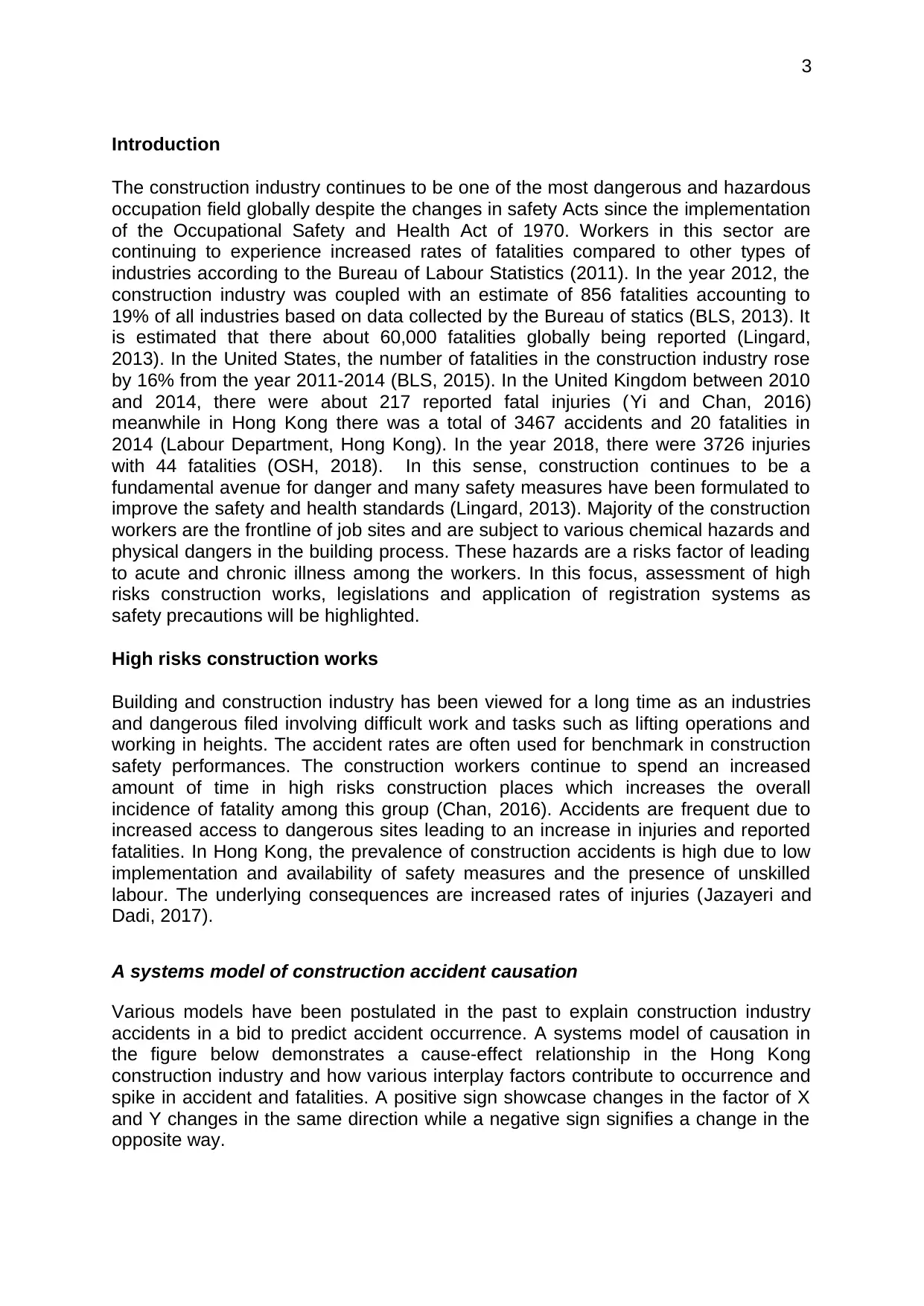
3
Introduction
The construction industry continues to be one of the most dangerous and hazardous
occupation field globally despite the changes in safety Acts since the implementation
of the Occupational Safety and Health Act of 1970. Workers in this sector are
continuing to experience increased rates of fatalities compared to other types of
industries according to the Bureau of Labour Statistics (2011). In the year 2012, the
construction industry was coupled with an estimate of 856 fatalities accounting to
19% of all industries based on data collected by the Bureau of statics (BLS, 2013). It
is estimated that there about 60,000 fatalities globally being reported (Lingard,
2013). In the United States, the number of fatalities in the construction industry rose
by 16% from the year 2011-2014 (BLS, 2015). In the United Kingdom between 2010
and 2014, there were about 217 reported fatal injuries (Yi and Chan, 2016)
meanwhile in Hong Kong there was a total of 3467 accidents and 20 fatalities in
2014 (Labour Department, Hong Kong). In the year 2018, there were 3726 injuries
with 44 fatalities (OSH, 2018). In this sense, construction continues to be a
fundamental avenue for danger and many safety measures have been formulated to
improve the safety and health standards (Lingard, 2013). Majority of the construction
workers are the frontline of job sites and are subject to various chemical hazards and
physical dangers in the building process. These hazards are a risks factor of leading
to acute and chronic illness among the workers. In this focus, assessment of high
risks construction works, legislations and application of registration systems as
safety precautions will be highlighted.
High risks construction works
Building and construction industry has been viewed for a long time as an industries
and dangerous filed involving difficult work and tasks such as lifting operations and
working in heights. The accident rates are often used for benchmark in construction
safety performances. The construction workers continue to spend an increased
amount of time in high risks construction places which increases the overall
incidence of fatality among this group (Chan, 2016). Accidents are frequent due to
increased access to dangerous sites leading to an increase in injuries and reported
fatalities. In Hong Kong, the prevalence of construction accidents is high due to low
implementation and availability of safety measures and the presence of unskilled
labour. The underlying consequences are increased rates of injuries (Jazayeri and
Dadi, 2017).
A systems model of construction accident causation
Various models have been postulated in the past to explain construction industry
accidents in a bid to predict accident occurrence. A systems model of causation in
the figure below demonstrates a cause-effect relationship in the Hong Kong
construction industry and how various interplay factors contribute to occurrence and
spike in accident and fatalities. A positive sign showcase changes in the factor of X
and Y changes in the same direction while a negative sign signifies a change in the
opposite way.
Introduction
The construction industry continues to be one of the most dangerous and hazardous
occupation field globally despite the changes in safety Acts since the implementation
of the Occupational Safety and Health Act of 1970. Workers in this sector are
continuing to experience increased rates of fatalities compared to other types of
industries according to the Bureau of Labour Statistics (2011). In the year 2012, the
construction industry was coupled with an estimate of 856 fatalities accounting to
19% of all industries based on data collected by the Bureau of statics (BLS, 2013). It
is estimated that there about 60,000 fatalities globally being reported (Lingard,
2013). In the United States, the number of fatalities in the construction industry rose
by 16% from the year 2011-2014 (BLS, 2015). In the United Kingdom between 2010
and 2014, there were about 217 reported fatal injuries (Yi and Chan, 2016)
meanwhile in Hong Kong there was a total of 3467 accidents and 20 fatalities in
2014 (Labour Department, Hong Kong). In the year 2018, there were 3726 injuries
with 44 fatalities (OSH, 2018). In this sense, construction continues to be a
fundamental avenue for danger and many safety measures have been formulated to
improve the safety and health standards (Lingard, 2013). Majority of the construction
workers are the frontline of job sites and are subject to various chemical hazards and
physical dangers in the building process. These hazards are a risks factor of leading
to acute and chronic illness among the workers. In this focus, assessment of high
risks construction works, legislations and application of registration systems as
safety precautions will be highlighted.
High risks construction works
Building and construction industry has been viewed for a long time as an industries
and dangerous filed involving difficult work and tasks such as lifting operations and
working in heights. The accident rates are often used for benchmark in construction
safety performances. The construction workers continue to spend an increased
amount of time in high risks construction places which increases the overall
incidence of fatality among this group (Chan, 2016). Accidents are frequent due to
increased access to dangerous sites leading to an increase in injuries and reported
fatalities. In Hong Kong, the prevalence of construction accidents is high due to low
implementation and availability of safety measures and the presence of unskilled
labour. The underlying consequences are increased rates of injuries (Jazayeri and
Dadi, 2017).
A systems model of construction accident causation
Various models have been postulated in the past to explain construction industry
accidents in a bid to predict accident occurrence. A systems model of causation in
the figure below demonstrates a cause-effect relationship in the Hong Kong
construction industry and how various interplay factors contribute to occurrence and
spike in accident and fatalities. A positive sign showcase changes in the factor of X
and Y changes in the same direction while a negative sign signifies a change in the
opposite way.
⊘ This is a preview!⊘
Do you want full access?
Subscribe today to unlock all pages.

Trusted by 1+ million students worldwide
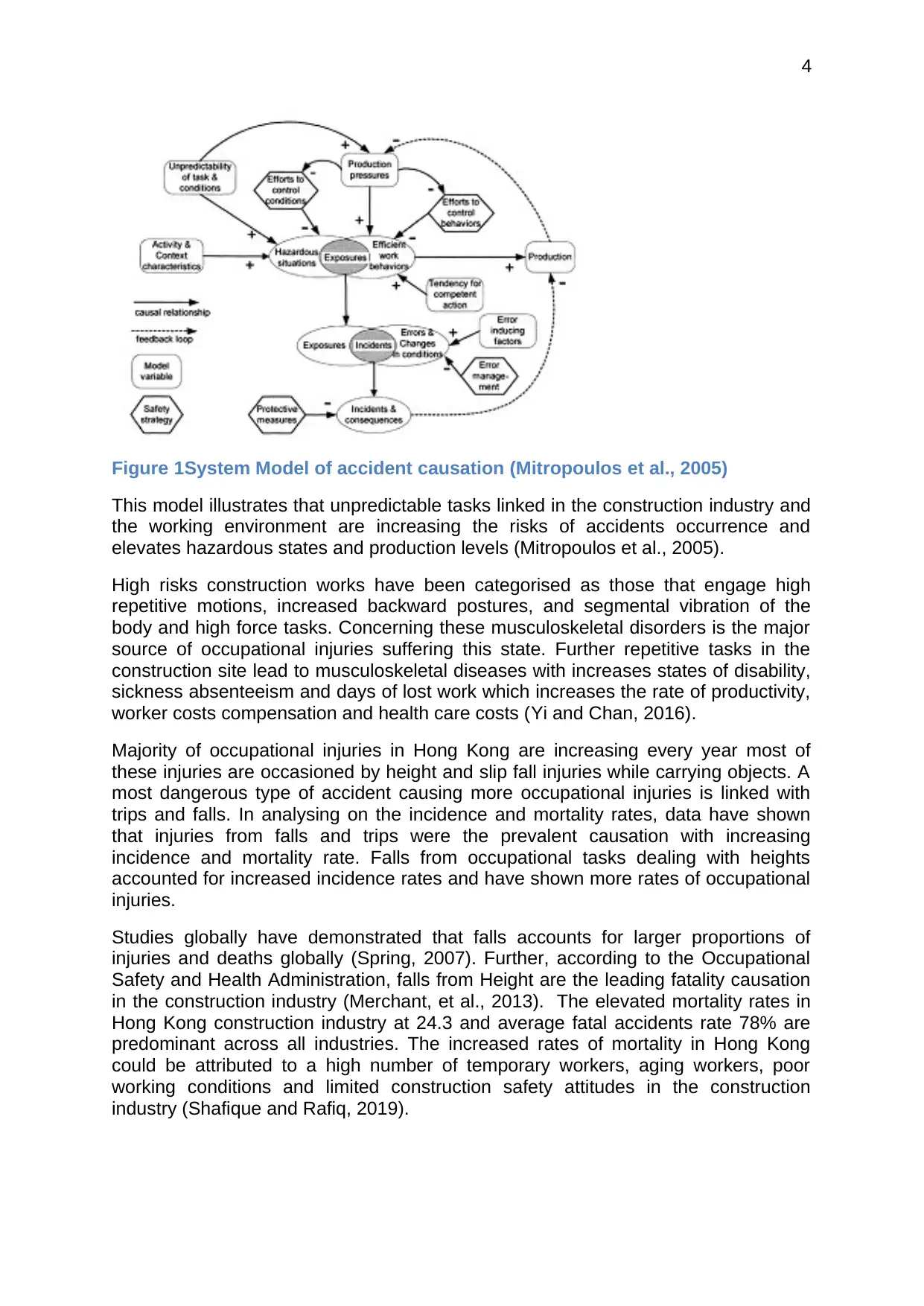
4
Figure 1System Model of accident causation (Mitropoulos et al., 2005)
This model illustrates that unpredictable tasks linked in the construction industry and
the working environment are increasing the risks of accidents occurrence and
elevates hazardous states and production levels (Mitropoulos et al., 2005).
High risks construction works have been categorised as those that engage high
repetitive motions, increased backward postures, and segmental vibration of the
body and high force tasks. Concerning these musculoskeletal disorders is the major
source of occupational injuries suffering this state. Further repetitive tasks in the
construction site lead to musculoskeletal diseases with increases states of disability,
sickness absenteeism and days of lost work which increases the rate of productivity,
worker costs compensation and health care costs (Yi and Chan, 2016).
Majority of occupational injuries in Hong Kong are increasing every year most of
these injuries are occasioned by height and slip fall injuries while carrying objects. A
most dangerous type of accident causing more occupational injuries is linked with
trips and falls. In analysing on the incidence and mortality rates, data have shown
that injuries from falls and trips were the prevalent causation with increasing
incidence and mortality rate. Falls from occupational tasks dealing with heights
accounted for increased incidence rates and have shown more rates of occupational
injuries.
Studies globally have demonstrated that falls accounts for larger proportions of
injuries and deaths globally (Spring, 2007). Further, according to the Occupational
Safety and Health Administration, falls from Height are the leading fatality causation
in the construction industry (Merchant, et al., 2013). The elevated mortality rates in
Hong Kong construction industry at 24.3 and average fatal accidents rate 78% are
predominant across all industries. The increased rates of mortality in Hong Kong
could be attributed to a high number of temporary workers, aging workers, poor
working conditions and limited construction safety attitudes in the construction
industry (Shafique and Rafiq, 2019).
Figure 1System Model of accident causation (Mitropoulos et al., 2005)
This model illustrates that unpredictable tasks linked in the construction industry and
the working environment are increasing the risks of accidents occurrence and
elevates hazardous states and production levels (Mitropoulos et al., 2005).
High risks construction works have been categorised as those that engage high
repetitive motions, increased backward postures, and segmental vibration of the
body and high force tasks. Concerning these musculoskeletal disorders is the major
source of occupational injuries suffering this state. Further repetitive tasks in the
construction site lead to musculoskeletal diseases with increases states of disability,
sickness absenteeism and days of lost work which increases the rate of productivity,
worker costs compensation and health care costs (Yi and Chan, 2016).
Majority of occupational injuries in Hong Kong are increasing every year most of
these injuries are occasioned by height and slip fall injuries while carrying objects. A
most dangerous type of accident causing more occupational injuries is linked with
trips and falls. In analysing on the incidence and mortality rates, data have shown
that injuries from falls and trips were the prevalent causation with increasing
incidence and mortality rate. Falls from occupational tasks dealing with heights
accounted for increased incidence rates and have shown more rates of occupational
injuries.
Studies globally have demonstrated that falls accounts for larger proportions of
injuries and deaths globally (Spring, 2007). Further, according to the Occupational
Safety and Health Administration, falls from Height are the leading fatality causation
in the construction industry (Merchant, et al., 2013). The elevated mortality rates in
Hong Kong construction industry at 24.3 and average fatal accidents rate 78% are
predominant across all industries. The increased rates of mortality in Hong Kong
could be attributed to a high number of temporary workers, aging workers, poor
working conditions and limited construction safety attitudes in the construction
industry (Shafique and Rafiq, 2019).
Paraphrase This Document
Need a fresh take? Get an instant paraphrase of this document with our AI Paraphraser
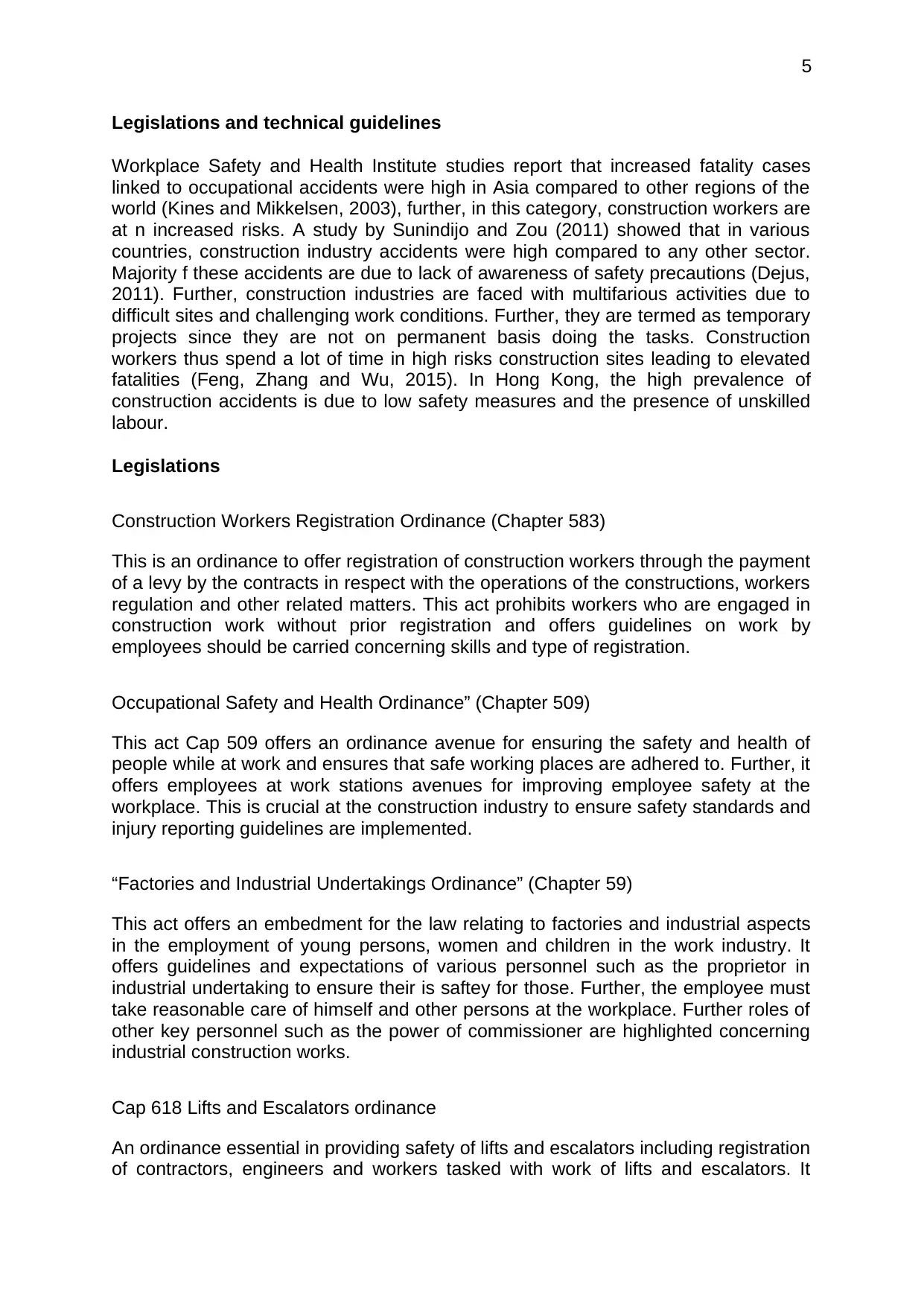
5
Legislations and technical guidelines
Workplace Safety and Health Institute studies report that increased fatality cases
linked to occupational accidents were high in Asia compared to other regions of the
world (Kines and Mikkelsen, 2003), further, in this category, construction workers are
at n increased risks. A study by Sunindijo and Zou (2011) showed that in various
countries, construction industry accidents were high compared to any other sector.
Majority f these accidents are due to lack of awareness of safety precautions (Dejus,
2011). Further, construction industries are faced with multifarious activities due to
difficult sites and challenging work conditions. Further, they are termed as temporary
projects since they are not on permanent basis doing the tasks. Construction
workers thus spend a lot of time in high risks construction sites leading to elevated
fatalities (Feng, Zhang and Wu, 2015). In Hong Kong, the high prevalence of
construction accidents is due to low safety measures and the presence of unskilled
labour.
Legislations
Construction Workers Registration Ordinance (Chapter 583)
This is an ordinance to offer registration of construction workers through the payment
of a levy by the contracts in respect with the operations of the constructions, workers
regulation and other related matters. This act prohibits workers who are engaged in
construction work without prior registration and offers guidelines on work by
employees should be carried concerning skills and type of registration.
Occupational Safety and Health Ordinance” (Chapter 509)
This act Cap 509 offers an ordinance avenue for ensuring the safety and health of
people while at work and ensures that safe working places are adhered to. Further, it
offers employees at work stations avenues for improving employee safety at the
workplace. This is crucial at the construction industry to ensure safety standards and
injury reporting guidelines are implemented.
“Factories and Industrial Undertakings Ordinance” (Chapter 59)
This act offers an embedment for the law relating to factories and industrial aspects
in the employment of young persons, women and children in the work industry. It
offers guidelines and expectations of various personnel such as the proprietor in
industrial undertaking to ensure their is saftey for those. Further, the employee must
take reasonable care of himself and other persons at the workplace. Further roles of
other key personnel such as the power of commissioner are highlighted concerning
industrial construction works.
Cap 618 Lifts and Escalators ordinance
An ordinance essential in providing safety of lifts and escalators including registration
of contractors, engineers and workers tasked with work of lifts and escalators. It
Legislations and technical guidelines
Workplace Safety and Health Institute studies report that increased fatality cases
linked to occupational accidents were high in Asia compared to other regions of the
world (Kines and Mikkelsen, 2003), further, in this category, construction workers are
at n increased risks. A study by Sunindijo and Zou (2011) showed that in various
countries, construction industry accidents were high compared to any other sector.
Majority f these accidents are due to lack of awareness of safety precautions (Dejus,
2011). Further, construction industries are faced with multifarious activities due to
difficult sites and challenging work conditions. Further, they are termed as temporary
projects since they are not on permanent basis doing the tasks. Construction
workers thus spend a lot of time in high risks construction sites leading to elevated
fatalities (Feng, Zhang and Wu, 2015). In Hong Kong, the high prevalence of
construction accidents is due to low safety measures and the presence of unskilled
labour.
Legislations
Construction Workers Registration Ordinance (Chapter 583)
This is an ordinance to offer registration of construction workers through the payment
of a levy by the contracts in respect with the operations of the constructions, workers
regulation and other related matters. This act prohibits workers who are engaged in
construction work without prior registration and offers guidelines on work by
employees should be carried concerning skills and type of registration.
Occupational Safety and Health Ordinance” (Chapter 509)
This act Cap 509 offers an ordinance avenue for ensuring the safety and health of
people while at work and ensures that safe working places are adhered to. Further, it
offers employees at work stations avenues for improving employee safety at the
workplace. This is crucial at the construction industry to ensure safety standards and
injury reporting guidelines are implemented.
“Factories and Industrial Undertakings Ordinance” (Chapter 59)
This act offers an embedment for the law relating to factories and industrial aspects
in the employment of young persons, women and children in the work industry. It
offers guidelines and expectations of various personnel such as the proprietor in
industrial undertaking to ensure their is saftey for those. Further, the employee must
take reasonable care of himself and other persons at the workplace. Further roles of
other key personnel such as the power of commissioner are highlighted concerning
industrial construction works.
Cap 618 Lifts and Escalators ordinance
An ordinance essential in providing safety of lifts and escalators including registration
of contractors, engineers and workers tasked with work of lifts and escalators. It
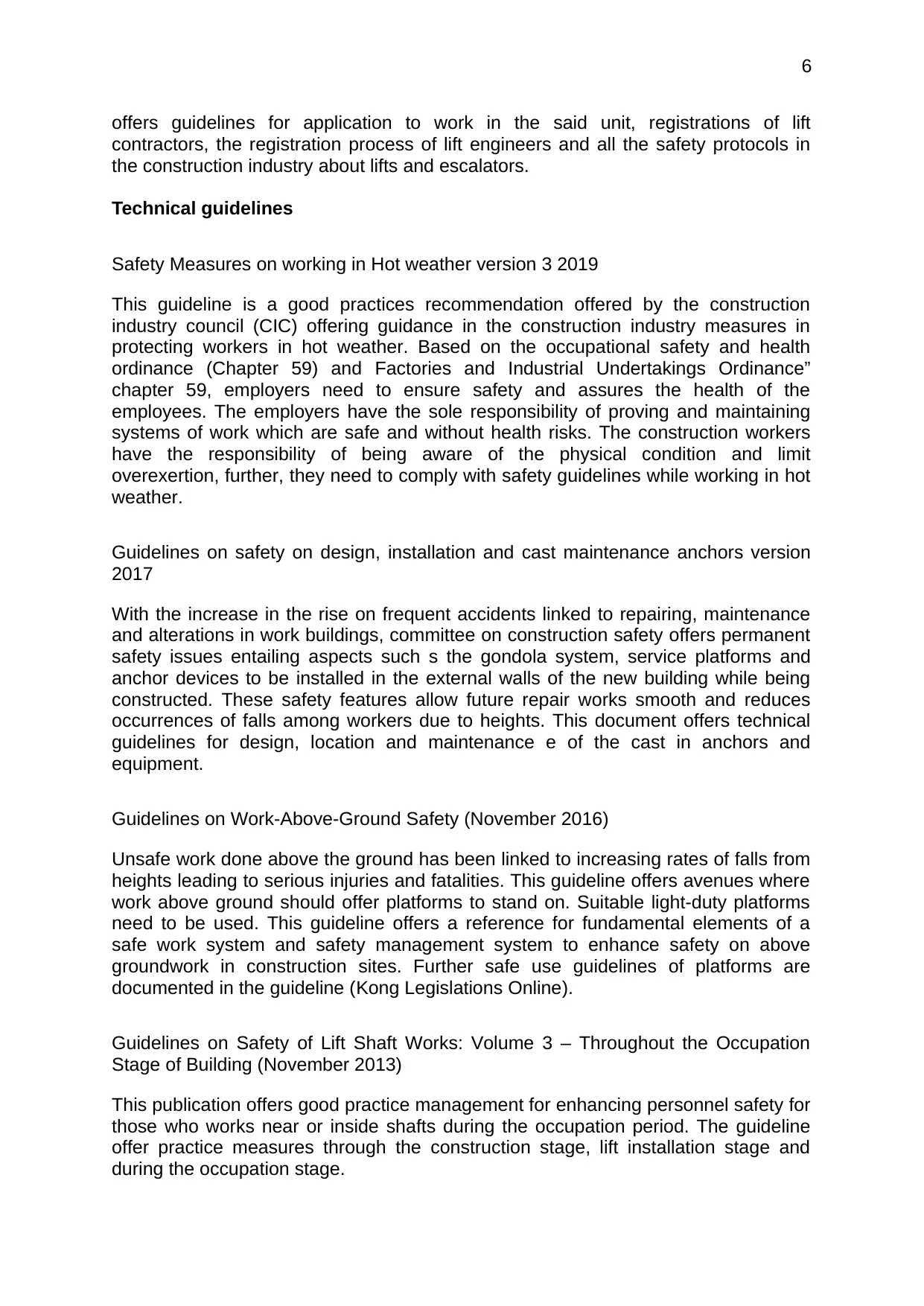
6
offers guidelines for application to work in the said unit, registrations of lift
contractors, the registration process of lift engineers and all the safety protocols in
the construction industry about lifts and escalators.
Technical guidelines
Safety Measures on working in Hot weather version 3 2019
This guideline is a good practices recommendation offered by the construction
industry council (CIC) offering guidance in the construction industry measures in
protecting workers in hot weather. Based on the occupational safety and health
ordinance (Chapter 59) and Factories and Industrial Undertakings Ordinance”
chapter 59, employers need to ensure safety and assures the health of the
employees. The employers have the sole responsibility of proving and maintaining
systems of work which are safe and without health risks. The construction workers
have the responsibility of being aware of the physical condition and limit
overexertion, further, they need to comply with safety guidelines while working in hot
weather.
Guidelines on safety on design, installation and cast maintenance anchors version
2017
With the increase in the rise on frequent accidents linked to repairing, maintenance
and alterations in work buildings, committee on construction safety offers permanent
safety issues entailing aspects such s the gondola system, service platforms and
anchor devices to be installed in the external walls of the new building while being
constructed. These safety features allow future repair works smooth and reduces
occurrences of falls among workers due to heights. This document offers technical
guidelines for design, location and maintenance e of the cast in anchors and
equipment.
Guidelines on Work-Above-Ground Safety (November 2016)
Unsafe work done above the ground has been linked to increasing rates of falls from
heights leading to serious injuries and fatalities. This guideline offers avenues where
work above ground should offer platforms to stand on. Suitable light-duty platforms
need to be used. This guideline offers a reference for fundamental elements of a
safe work system and safety management system to enhance safety on above
groundwork in construction sites. Further safe use guidelines of platforms are
documented in the guideline (Kong Legislations Online).
Guidelines on Safety of Lift Shaft Works: Volume 3 – Throughout the Occupation
Stage of Building (November 2013)
This publication offers good practice management for enhancing personnel safety for
those who works near or inside shafts during the occupation period. The guideline
offer practice measures through the construction stage, lift installation stage and
during the occupation stage.
offers guidelines for application to work in the said unit, registrations of lift
contractors, the registration process of lift engineers and all the safety protocols in
the construction industry about lifts and escalators.
Technical guidelines
Safety Measures on working in Hot weather version 3 2019
This guideline is a good practices recommendation offered by the construction
industry council (CIC) offering guidance in the construction industry measures in
protecting workers in hot weather. Based on the occupational safety and health
ordinance (Chapter 59) and Factories and Industrial Undertakings Ordinance”
chapter 59, employers need to ensure safety and assures the health of the
employees. The employers have the sole responsibility of proving and maintaining
systems of work which are safe and without health risks. The construction workers
have the responsibility of being aware of the physical condition and limit
overexertion, further, they need to comply with safety guidelines while working in hot
weather.
Guidelines on safety on design, installation and cast maintenance anchors version
2017
With the increase in the rise on frequent accidents linked to repairing, maintenance
and alterations in work buildings, committee on construction safety offers permanent
safety issues entailing aspects such s the gondola system, service platforms and
anchor devices to be installed in the external walls of the new building while being
constructed. These safety features allow future repair works smooth and reduces
occurrences of falls among workers due to heights. This document offers technical
guidelines for design, location and maintenance e of the cast in anchors and
equipment.
Guidelines on Work-Above-Ground Safety (November 2016)
Unsafe work done above the ground has been linked to increasing rates of falls from
heights leading to serious injuries and fatalities. This guideline offers avenues where
work above ground should offer platforms to stand on. Suitable light-duty platforms
need to be used. This guideline offers a reference for fundamental elements of a
safe work system and safety management system to enhance safety on above
groundwork in construction sites. Further safe use guidelines of platforms are
documented in the guideline (Kong Legislations Online).
Guidelines on Safety of Lift Shaft Works: Volume 3 – Throughout the Occupation
Stage of Building (November 2013)
This publication offers good practice management for enhancing personnel safety for
those who works near or inside shafts during the occupation period. The guideline
offer practice measures through the construction stage, lift installation stage and
during the occupation stage.
⊘ This is a preview!⊘
Do you want full access?
Subscribe today to unlock all pages.

Trusted by 1+ million students worldwide
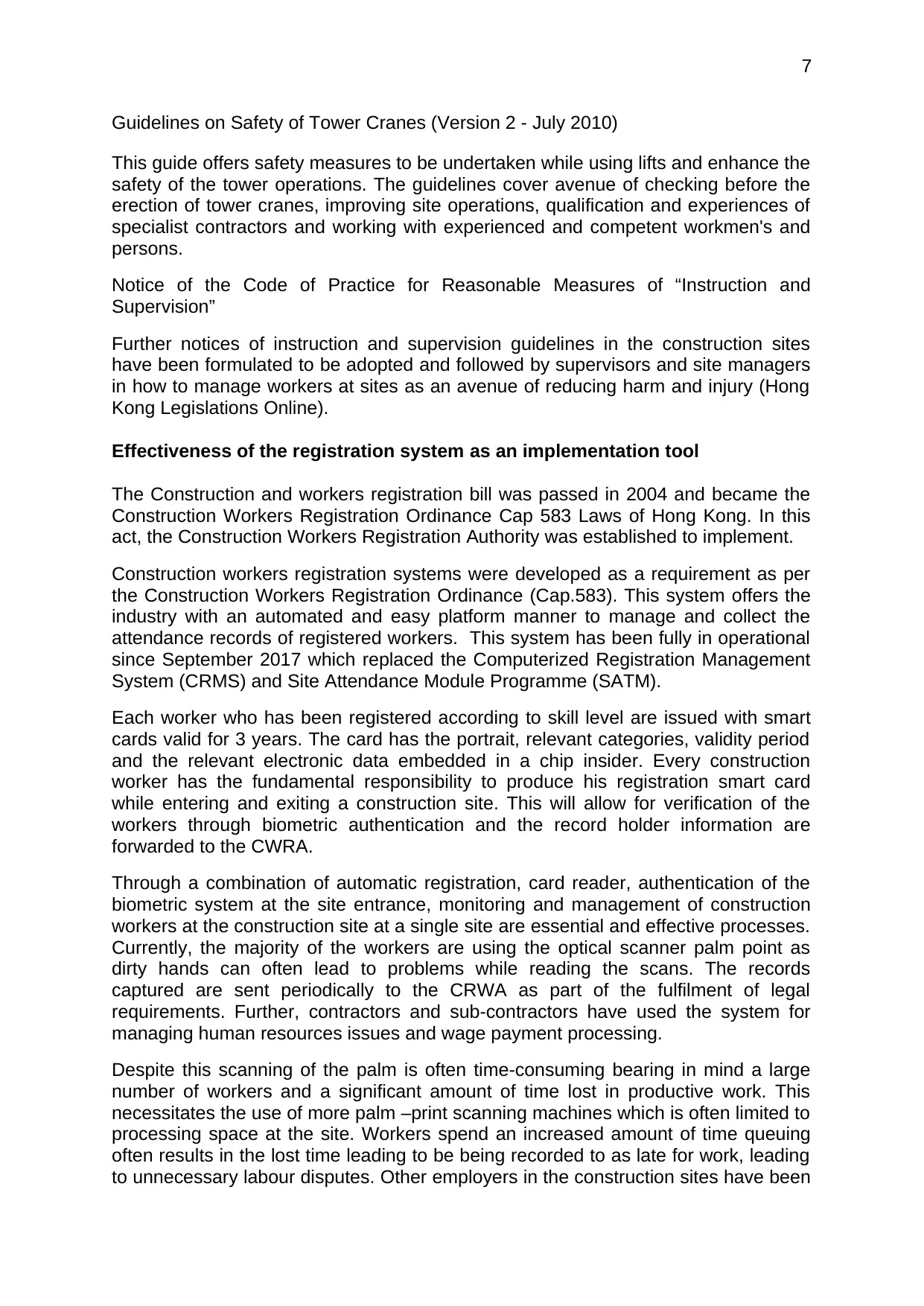
7
Guidelines on Safety of Tower Cranes (Version 2 - July 2010)
This guide offers safety measures to be undertaken while using lifts and enhance the
safety of the tower operations. The guidelines cover avenue of checking before the
erection of tower cranes, improving site operations, qualification and experiences of
specialist contractors and working with experienced and competent workmen's and
persons.
Notice of the Code of Practice for Reasonable Measures of “Instruction and
Supervision”
Further notices of instruction and supervision guidelines in the construction sites
have been formulated to be adopted and followed by supervisors and site managers
in how to manage workers at sites as an avenue of reducing harm and injury (Hong
Kong Legislations Online).
Effectiveness of the registration system as an implementation tool
The Construction and workers registration bill was passed in 2004 and became the
Construction Workers Registration Ordinance Cap 583 Laws of Hong Kong. In this
act, the Construction Workers Registration Authority was established to implement.
Construction workers registration systems were developed as a requirement as per
the Construction Workers Registration Ordinance (Cap.583). This system offers the
industry with an automated and easy platform manner to manage and collect the
attendance records of registered workers. This system has been fully in operational
since September 2017 which replaced the Computerized Registration Management
System (CRMS) and Site Attendance Module Programme (SATM).
Each worker who has been registered according to skill level are issued with smart
cards valid for 3 years. The card has the portrait, relevant categories, validity period
and the relevant electronic data embedded in a chip insider. Every construction
worker has the fundamental responsibility to produce his registration smart card
while entering and exiting a construction site. This will allow for verification of the
workers through biometric authentication and the record holder information are
forwarded to the CWRA.
Through a combination of automatic registration, card reader, authentication of the
biometric system at the site entrance, monitoring and management of construction
workers at the construction site at a single site are essential and effective processes.
Currently, the majority of the workers are using the optical scanner palm point as
dirty hands can often lead to problems while reading the scans. The records
captured are sent periodically to the CRWA as part of the fulfilment of legal
requirements. Further, contractors and sub-contractors have used the system for
managing human resources issues and wage payment processing.
Despite this scanning of the palm is often time-consuming bearing in mind a large
number of workers and a significant amount of time lost in productive work. This
necessitates the use of more palm –print scanning machines which is often limited to
processing space at the site. Workers spend an increased amount of time queuing
often results in the lost time leading to be being recorded to as late for work, leading
to unnecessary labour disputes. Other employers in the construction sites have been
Guidelines on Safety of Tower Cranes (Version 2 - July 2010)
This guide offers safety measures to be undertaken while using lifts and enhance the
safety of the tower operations. The guidelines cover avenue of checking before the
erection of tower cranes, improving site operations, qualification and experiences of
specialist contractors and working with experienced and competent workmen's and
persons.
Notice of the Code of Practice for Reasonable Measures of “Instruction and
Supervision”
Further notices of instruction and supervision guidelines in the construction sites
have been formulated to be adopted and followed by supervisors and site managers
in how to manage workers at sites as an avenue of reducing harm and injury (Hong
Kong Legislations Online).
Effectiveness of the registration system as an implementation tool
The Construction and workers registration bill was passed in 2004 and became the
Construction Workers Registration Ordinance Cap 583 Laws of Hong Kong. In this
act, the Construction Workers Registration Authority was established to implement.
Construction workers registration systems were developed as a requirement as per
the Construction Workers Registration Ordinance (Cap.583). This system offers the
industry with an automated and easy platform manner to manage and collect the
attendance records of registered workers. This system has been fully in operational
since September 2017 which replaced the Computerized Registration Management
System (CRMS) and Site Attendance Module Programme (SATM).
Each worker who has been registered according to skill level are issued with smart
cards valid for 3 years. The card has the portrait, relevant categories, validity period
and the relevant electronic data embedded in a chip insider. Every construction
worker has the fundamental responsibility to produce his registration smart card
while entering and exiting a construction site. This will allow for verification of the
workers through biometric authentication and the record holder information are
forwarded to the CWRA.
Through a combination of automatic registration, card reader, authentication of the
biometric system at the site entrance, monitoring and management of construction
workers at the construction site at a single site are essential and effective processes.
Currently, the majority of the workers are using the optical scanner palm point as
dirty hands can often lead to problems while reading the scans. The records
captured are sent periodically to the CRWA as part of the fulfilment of legal
requirements. Further, contractors and sub-contractors have used the system for
managing human resources issues and wage payment processing.
Despite this scanning of the palm is often time-consuming bearing in mind a large
number of workers and a significant amount of time lost in productive work. This
necessitates the use of more palm –print scanning machines which is often limited to
processing space at the site. Workers spend an increased amount of time queuing
often results in the lost time leading to be being recorded to as late for work, leading
to unnecessary labour disputes. Other employers in the construction sites have been
Paraphrase This Document
Need a fresh take? Get an instant paraphrase of this document with our AI Paraphraser
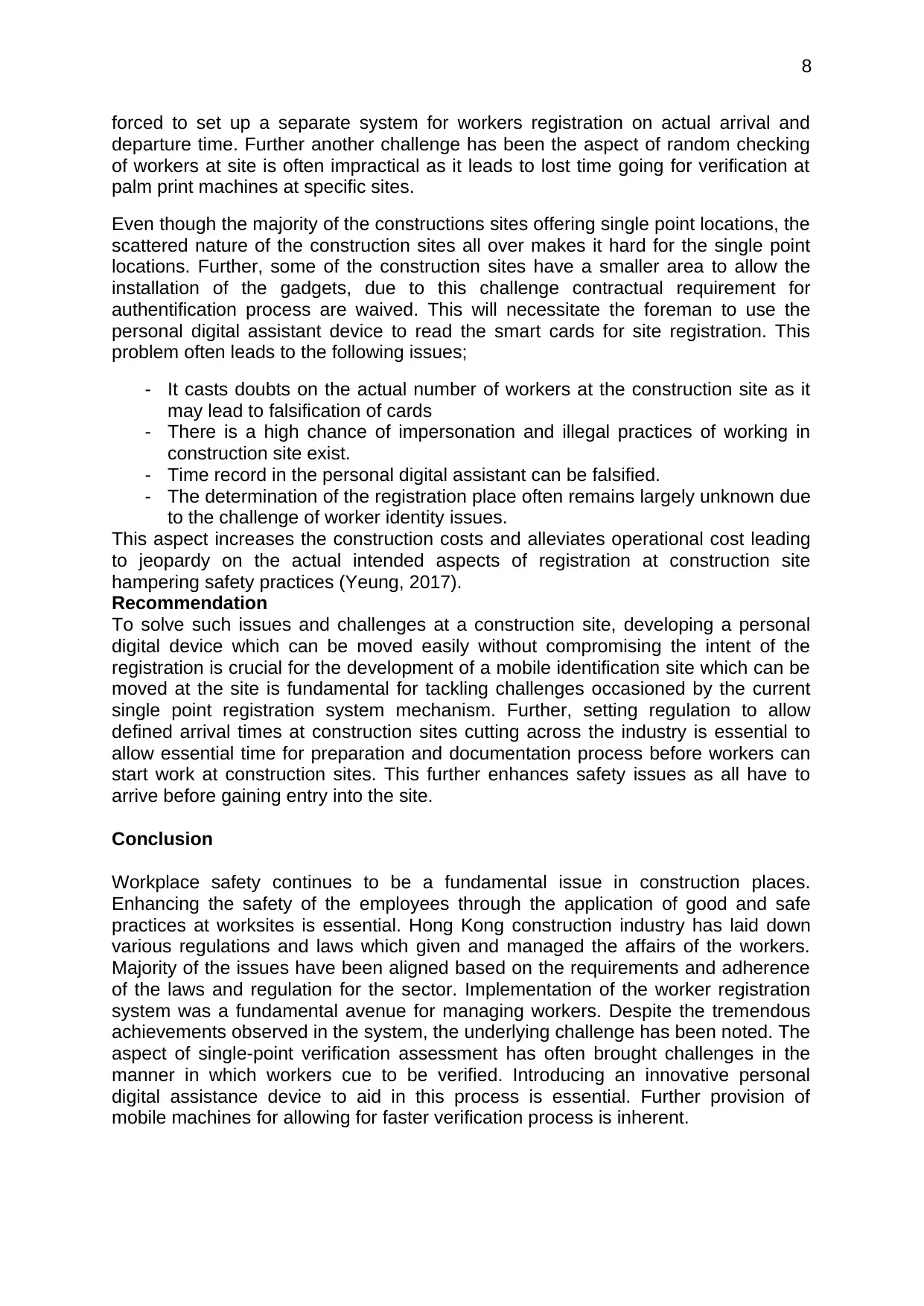
8
forced to set up a separate system for workers registration on actual arrival and
departure time. Further another challenge has been the aspect of random checking
of workers at site is often impractical as it leads to lost time going for verification at
palm print machines at specific sites.
Even though the majority of the constructions sites offering single point locations, the
scattered nature of the construction sites all over makes it hard for the single point
locations. Further, some of the construction sites have a smaller area to allow the
installation of the gadgets, due to this challenge contractual requirement for
authentification process are waived. This will necessitate the foreman to use the
personal digital assistant device to read the smart cards for site registration. This
problem often leads to the following issues;
- It casts doubts on the actual number of workers at the construction site as it
may lead to falsification of cards
- There is a high chance of impersonation and illegal practices of working in
construction site exist.
- Time record in the personal digital assistant can be falsified.
- The determination of the registration place often remains largely unknown due
to the challenge of worker identity issues.
This aspect increases the construction costs and alleviates operational cost leading
to jeopardy on the actual intended aspects of registration at construction site
hampering safety practices (Yeung, 2017).
Recommendation
To solve such issues and challenges at a construction site, developing a personal
digital device which can be moved easily without compromising the intent of the
registration is crucial for the development of a mobile identification site which can be
moved at the site is fundamental for tackling challenges occasioned by the current
single point registration system mechanism. Further, setting regulation to allow
defined arrival times at construction sites cutting across the industry is essential to
allow essential time for preparation and documentation process before workers can
start work at construction sites. This further enhances safety issues as all have to
arrive before gaining entry into the site.
Conclusion
Workplace safety continues to be a fundamental issue in construction places.
Enhancing the safety of the employees through the application of good and safe
practices at worksites is essential. Hong Kong construction industry has laid down
various regulations and laws which given and managed the affairs of the workers.
Majority of the issues have been aligned based on the requirements and adherence
of the laws and regulation for the sector. Implementation of the worker registration
system was a fundamental avenue for managing workers. Despite the tremendous
achievements observed in the system, the underlying challenge has been noted. The
aspect of single-point verification assessment has often brought challenges in the
manner in which workers cue to be verified. Introducing an innovative personal
digital assistance device to aid in this process is essential. Further provision of
mobile machines for allowing for faster verification process is inherent.
forced to set up a separate system for workers registration on actual arrival and
departure time. Further another challenge has been the aspect of random checking
of workers at site is often impractical as it leads to lost time going for verification at
palm print machines at specific sites.
Even though the majority of the constructions sites offering single point locations, the
scattered nature of the construction sites all over makes it hard for the single point
locations. Further, some of the construction sites have a smaller area to allow the
installation of the gadgets, due to this challenge contractual requirement for
authentification process are waived. This will necessitate the foreman to use the
personal digital assistant device to read the smart cards for site registration. This
problem often leads to the following issues;
- It casts doubts on the actual number of workers at the construction site as it
may lead to falsification of cards
- There is a high chance of impersonation and illegal practices of working in
construction site exist.
- Time record in the personal digital assistant can be falsified.
- The determination of the registration place often remains largely unknown due
to the challenge of worker identity issues.
This aspect increases the construction costs and alleviates operational cost leading
to jeopardy on the actual intended aspects of registration at construction site
hampering safety practices (Yeung, 2017).
Recommendation
To solve such issues and challenges at a construction site, developing a personal
digital device which can be moved easily without compromising the intent of the
registration is crucial for the development of a mobile identification site which can be
moved at the site is fundamental for tackling challenges occasioned by the current
single point registration system mechanism. Further, setting regulation to allow
defined arrival times at construction sites cutting across the industry is essential to
allow essential time for preparation and documentation process before workers can
start work at construction sites. This further enhances safety issues as all have to
arrive before gaining entry into the site.
Conclusion
Workplace safety continues to be a fundamental issue in construction places.
Enhancing the safety of the employees through the application of good and safe
practices at worksites is essential. Hong Kong construction industry has laid down
various regulations and laws which given and managed the affairs of the workers.
Majority of the issues have been aligned based on the requirements and adherence
of the laws and regulation for the sector. Implementation of the worker registration
system was a fundamental avenue for managing workers. Despite the tremendous
achievements observed in the system, the underlying challenge has been noted. The
aspect of single-point verification assessment has often brought challenges in the
manner in which workers cue to be verified. Introducing an innovative personal
digital assistance device to aid in this process is essential. Further provision of
mobile machines for allowing for faster verification process is inherent.
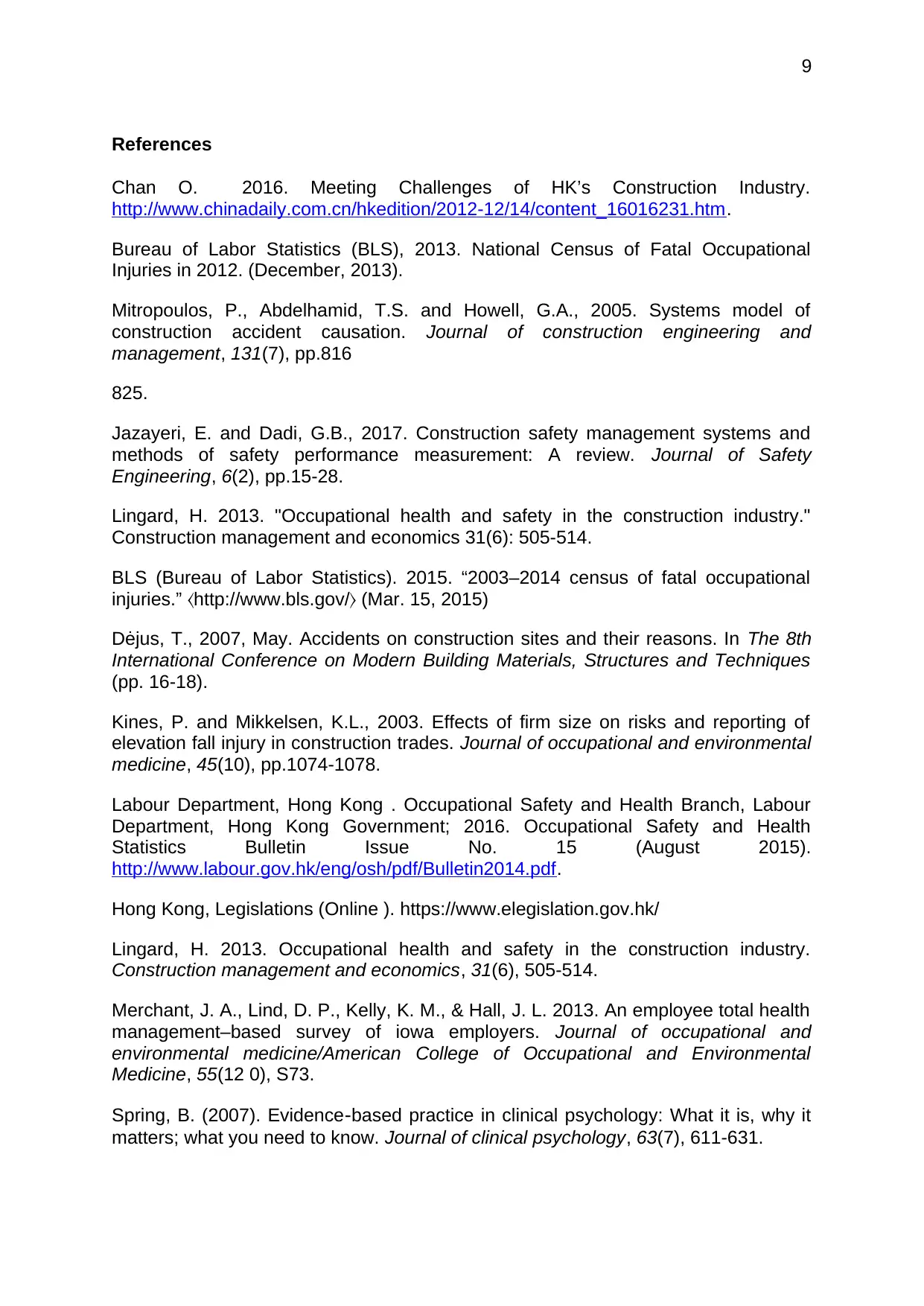
9
References
Chan O. 2016. Meeting Challenges of HK’s Construction Industry.
http://www.chinadaily.com.cn/hkedition/2012-12/14/content_16016231.htm.
Bureau of Labor Statistics (BLS), 2013. National Census of Fatal Occupational
Injuries in 2012. (December, 2013).
Mitropoulos, P., Abdelhamid, T.S. and Howell, G.A., 2005. Systems model of
construction accident causation. Journal of construction engineering and
management, 131(7), pp.816
825.
Jazayeri, E. and Dadi, G.B., 2017. Construction safety management systems and
methods of safety performance measurement: A review. Journal of Safety
Engineering, 6(2), pp.15-28.
Lingard, H. 2013. "Occupational health and safety in the construction industry."
Construction management and economics 31(6): 505-514.
BLS (Bureau of Labor Statistics). 2015. “2003–2014 census of fatal occupational
injuries.” http://www.bls.gov/ (Mar. 15, 2015)〈 〉
Dėjus, T., 2007, May. Accidents on construction sites and their reasons. In The 8th
International Conference on Modern Building Materials, Structures and Techniques
(pp. 16-18).
Kines, P. and Mikkelsen, K.L., 2003. Effects of firm size on risks and reporting of
elevation fall injury in construction trades. Journal of occupational and environmental
medicine, 45(10), pp.1074-1078.
Labour Department, Hong Kong . Occupational Safety and Health Branch, Labour
Department, Hong Kong Government; 2016. Occupational Safety and Health
Statistics Bulletin Issue No. 15 (August 2015).
http://www.labour.gov.hk/eng/osh/pdf/Bulletin2014.pdf.
Hong Kong, Legislations (Online ). https://www.elegislation.gov.hk/
Lingard, H. 2013. Occupational health and safety in the construction industry.
Construction management and economics, 31(6), 505-514.
Merchant, J. A., Lind, D. P., Kelly, K. M., & Hall, J. L. 2013. An employee total health
management–based survey of iowa employers. Journal of occupational and
environmental medicine/American College of Occupational and Environmental
Medicine, 55(12 0), S73.
Spring, B. (2007). Evidence‐based practice in clinical psychology: What it is, why it
matters; what you need to know. Journal of clinical psychology, 63(7), 611-631.
References
Chan O. 2016. Meeting Challenges of HK’s Construction Industry.
http://www.chinadaily.com.cn/hkedition/2012-12/14/content_16016231.htm.
Bureau of Labor Statistics (BLS), 2013. National Census of Fatal Occupational
Injuries in 2012. (December, 2013).
Mitropoulos, P., Abdelhamid, T.S. and Howell, G.A., 2005. Systems model of
construction accident causation. Journal of construction engineering and
management, 131(7), pp.816
825.
Jazayeri, E. and Dadi, G.B., 2017. Construction safety management systems and
methods of safety performance measurement: A review. Journal of Safety
Engineering, 6(2), pp.15-28.
Lingard, H. 2013. "Occupational health and safety in the construction industry."
Construction management and economics 31(6): 505-514.
BLS (Bureau of Labor Statistics). 2015. “2003–2014 census of fatal occupational
injuries.” http://www.bls.gov/ (Mar. 15, 2015)〈 〉
Dėjus, T., 2007, May. Accidents on construction sites and their reasons. In The 8th
International Conference on Modern Building Materials, Structures and Techniques
(pp. 16-18).
Kines, P. and Mikkelsen, K.L., 2003. Effects of firm size on risks and reporting of
elevation fall injury in construction trades. Journal of occupational and environmental
medicine, 45(10), pp.1074-1078.
Labour Department, Hong Kong . Occupational Safety and Health Branch, Labour
Department, Hong Kong Government; 2016. Occupational Safety and Health
Statistics Bulletin Issue No. 15 (August 2015).
http://www.labour.gov.hk/eng/osh/pdf/Bulletin2014.pdf.
Hong Kong, Legislations (Online ). https://www.elegislation.gov.hk/
Lingard, H. 2013. Occupational health and safety in the construction industry.
Construction management and economics, 31(6), 505-514.
Merchant, J. A., Lind, D. P., Kelly, K. M., & Hall, J. L. 2013. An employee total health
management–based survey of iowa employers. Journal of occupational and
environmental medicine/American College of Occupational and Environmental
Medicine, 55(12 0), S73.
Spring, B. (2007). Evidence‐based practice in clinical psychology: What it is, why it
matters; what you need to know. Journal of clinical psychology, 63(7), 611-631.
⊘ This is a preview!⊘
Do you want full access?
Subscribe today to unlock all pages.

Trusted by 1+ million students worldwide

10
Sunindijo, R.Y. and Zou, P.X., 2012. Political skill for developing construction safety
climate. Journal of Construction Engineering and Management, 138(5), pp.605-612.
Yeung, A.T., 2017. A mobile biometric authentication system for site management in
Hong Kong. Proceedings of the Institution of Civil Engineers-Management,
Procurement and Law, 170(4), pp.172-180.
Yi, W. and Chan, A., 2016. Health profile of construction workers in Hong Kong.
International journal of environmental research and public health, 13(12), p.1232.
Sunindijo, R.Y. and Zou, P.X., 2012. Political skill for developing construction safety
climate. Journal of Construction Engineering and Management, 138(5), pp.605-612.
Yeung, A.T., 2017. A mobile biometric authentication system for site management in
Hong Kong. Proceedings of the Institution of Civil Engineers-Management,
Procurement and Law, 170(4), pp.172-180.
Yi, W. and Chan, A., 2016. Health profile of construction workers in Hong Kong.
International journal of environmental research and public health, 13(12), p.1232.
1 out of 10
Related Documents
Your All-in-One AI-Powered Toolkit for Academic Success.
+13062052269
info@desklib.com
Available 24*7 on WhatsApp / Email
![[object Object]](/_next/static/media/star-bottom.7253800d.svg)
Unlock your academic potential
© 2024 | Zucol Services PVT LTD | All rights reserved.




